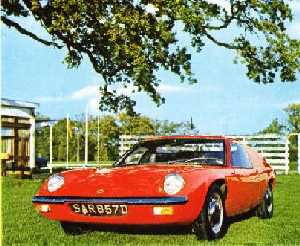


Somewhere back in 1964 it dawned on Colin Chapman that he needed a replacement for the Lotus 7. The car was becoming outdated and he needed more work for Lotus Components, the builders of the 7, which he hoped to achieve with this new car. In line with the Lotus racing cars of the days, the car was to be mid-engined. A revolutionary concept at the time as only the small volume Bonnet Djet was on the market with this engine placement. As no suitable engine gearbox was available at the time the actual development had to wait. There was no good transaxle on the market and as an engine Lotus's own Ford Twin-Cam engine was too expensive. When Chapman saw the new Renault 16 on the Paris Motor Show he immediately recognised its potential as he could see the possibilities of this engine and gearbox assembly. He only had to turn the assembly 180° and get the final drive to run in the opposite direction and he has the engine for his 7 replacement. He turned to his friend Gerard 'Jabby' Crombac who through his connections at La Regie secured a deal for Lotus for the 1470cc version (697-04) that was uprated to 82 BHP instead of the 52 BHP for the R16 version (697-01). This was an automotive version of Renault's own marine engine (697-03).
For the development of the new car, project P5, Chapman turned to the director of Lotus Engineering, Ron Hickman - later to become world famous for designing the Work-Mate. Hickman had a design ready, which could be used as a master plan for the new car. It was a design which Hickman had made in 1963 to impress the people from Ford, who came in to negotiate a contract of the Ford GT40, which later was given Lola. The design since then became known as the Lola beater. The budget for the development of the new car was a point of argument between Chapman and Hickman. Hickman finally declined the project since he felt it needed at least £40,000 whereas Chapman only wanted to go as far as £11,000. As this was the case Chapman himself took charge of the design. Hickman lend some of his staff for the project: Derek Sleath, Ian Jones, Alan Barret and Steve Sanville, together with John Joyce who was responsible for the race version the later 47. Outsiders that were contracted for the project were John Fraylings, who had also been involved with the Elite, for the design of the exterior and Peter Cambridge for the interior.
So the Europa became a car which combined ideas of these men. Chapman wanted a simple car as the car still was to replace the Seven and the target price was £650. In order to achieve this several features were suggested by Chapman: fixed chassis and fixed windows like on the racer from which it was derived. This also involved the final design of the interior with fixed seats and adjustable steering and pedals. When a final version of the car was presented, he however changed his mind. This was however at a stage in the development when this could not be altered. Therefore several changes had to wait till the introduction of the S2. So the S1 as it later became known had distinct features: more rigid by bonding body and frame; lighter by fixed windows and seats and a no-frills dashboard. It had better aerodynamics thanks to the almost completely closed underside, which on account of one mould for the complete underside also lacked edges which later car have.
Although Lotus promoted the S2 as a better car than the S1 it is a different concept, but not a better car from a driving point of view. The interior was changed on direction of Chapman and he also ordered to make the chassis removable. This latest was done on account of the insurance, which would become very costly due to very high repair cost once the chassis would be damaged in a crash. The production cost might have played a role, since although the S1 moulds were simpler and this does not apply to the actual building of the car. So although one of the reasons for opting for a bonded chassis was to cut cost it might actually been more expensive. The interior design of the S2 gave the car a more upmarket style. The old design dashboard however contributed to the stiffness of the body. Also the seat section in the S1 is also an integral part of the whole structure and due to its form much stiffer than the later bulkhead of S2's and TC's. These facts were however not noticed by road tester at the time the S2 was launched. They noted the smoother quieter ride. The S1 is not a car built for comfort, it is a drivers car.
A drawback that most period articles complain about is the lack of the outright power of the Ford-Lotus Twin Cam engine of the Elan. Most Lotus fans therefor prefer the Europa TC or Special. Although a Europa S1 is not by definition slower from A to B than an Elan, thanks to its enormous cornering power and slippery shape. Lotus still recognised a stronger engine would be preferable and have made several attempts to get a stronger Renault engine, but as there prime advocate at Renault, Bob Sicot, had left that firm and Jean Redelé of Alpine preferred not to have to compete with what he must have considered to be his own engine, they were stuck with the
The technical data of the Lotus Europa S1
visits since 22-04-1998
last revised , Delft, Holland